2019 Esker Elkat
Size Tested: Medium
Geometry: (Here)
Build Overview:
- Drivetrain: Shimano XT
- Brakes: Shimano XT
- Fork: Fox 36 Factory Fit4
- Rear Shock: Fox DPS Performance
- Wheels: Stans Baron
Wheels: 27.5′′
Travel: 150 mm rear / 160 mm front
Blister’s Measured Weight: 31.8 lbs (14.42 kg) without pedals
Reviewer: 5’9”, 155 lbs
MSRP: $4,000 base; $5,150 as built
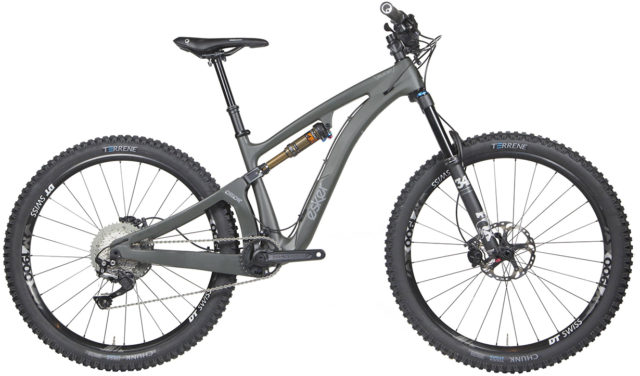
Intro
Esker is a brand that most people aren’t familiar with — they’re a new company, but the people behind Esker aren’t new to the bike industry. The Esker crew comes from, among other places, time spent working on assorted QBP brands, and notably, Dave Weagle was heavily involved in designing the Elkat’s suspension. In other words, the Elkat isn’t the result of garage tinkerers trying to sell their creation — it’s an effort to bring a new, competitive brand into the marketplace.
For the moment, Esker is offering two models — the Hayduke, a steel hardtail designed to accommodate a few different wheel and tire sizes, and the Elkat, which I rode. The Elkat is a 150mm-travel Trail / Enduro / All Mountain / whatever you want to call a 150mm-travel bike these days.
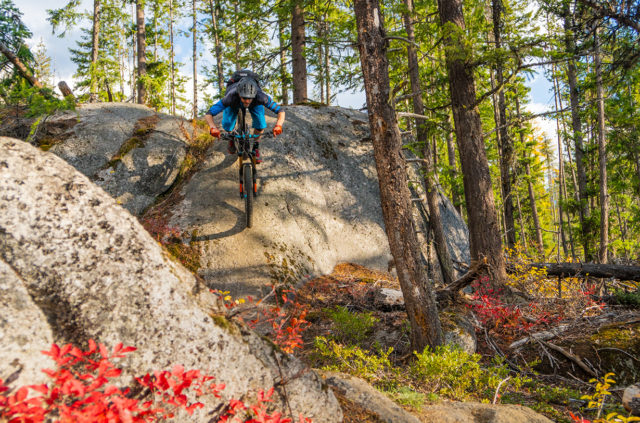
Esker, to their credit, doesn’t try to pigeonhole the Elkat into any particular label or category. And based on my time on the bike, that’s a good thing — it does a pretty good job of straddling a couple different categories, which I think makes it more well rounded than some other bikes it might compete against.
But I’m getting ahead of myself. Read on…
The Frame
The Elkat is only available as a carbon frame with 150 mm travel. It’s built around 27.5” wheels and Esker advertises tire clearance up to 2.6”. The Elkat cleared the 2.6’s I had on there without issue, so you could potentially cram some smaller 2.8’s in there, but it’d make the bike noticeably taller.
The Elkat’s frame is built around a new, patented suspension design from Dave Weagle called “Orion.” The basic layout of the design is somewhat similar to a DW link, except the bottom link rotates concentrically to the bottom bracket. So there are two short links that attach the front triangle to the rear triangle, and the lower one rotates around the bottom bracket. The shock is actuated by a clevis mount around the seat tube, and the shock is mounted under the top tube.
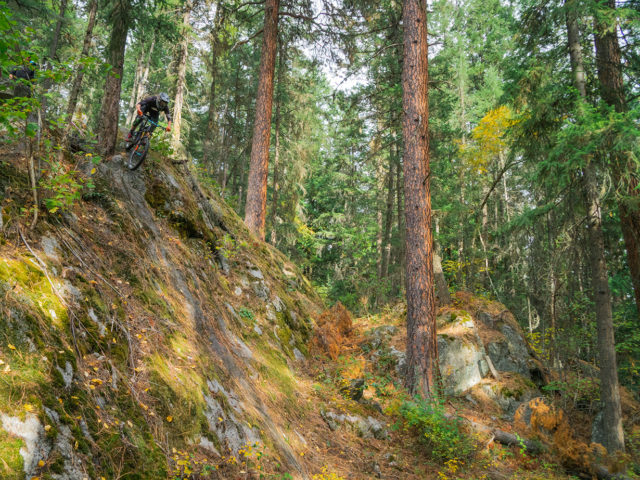
I’ll get into the details of the suspension below, but a couple things are worth pointing out.
(1) This style of suspension means there’s a solid rear triangle without any pivots near the axle. Oftentimes, this allows the bike to have a stiffer rear end.
(2) The shock placement under the top tube means that levers on the shock to firm things up are easy to reach, and it also means there’s enough room in the front triangle to fit a water bottle (huzzah!).
(3) Since the bottom pivot surrounds the bottom bracket, that means the bottom bracket shell is part of the pivot. And that means it’s made out of aluminum. And that means it’s threaded. Which is great, because press-fit bottom brackets creak and are annoying to work on.
Cable routing for the Elkat’s derailleur and dropper post are internal, and pretty normal by modern bike standards. Routing for the rear brake is external, which is great because routing hydraulic lines internally just means that, at some point, I’m going to have to do some maintenance that involves taking apart a hydraulic line, and it’s going to make me angry.
The Elkat’s frame is built around a Boost / 148 mm rear hub spacing, which is pretty normal these days. The rear axle is from DT Swiss, which I’ve always found to work well. The only note here is that the non-drive-side dropout is pretty deeply recessed, which made it a little funny getting the axle on and off.
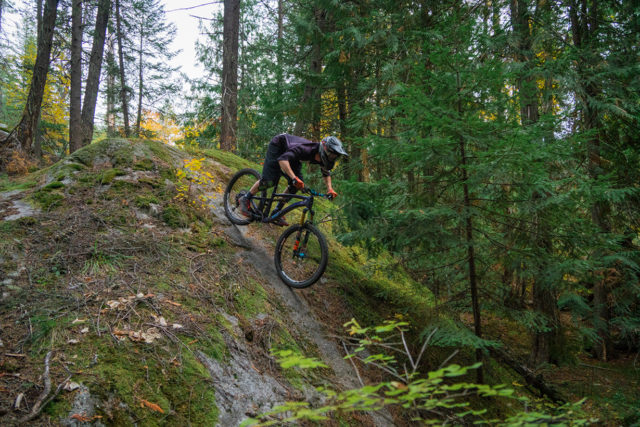
Elkat frames also include a Wolftooth headset and a custom bashguard / chainguide from E*Thirteen. The custom chainguide is necessary to fit around the Orion suspension design — the frame has 2 out of 3 of the normal ISCG mounts, so the guide needs to be modified to fit. The Elkat I rode was a pre-production model that didn’t have the chainguide on it so I can’t comment there other than to say that my chain fell off a couple times, so having a guide would be nice.
And since the Elkat I rode was a pre-production model, it didn’t have any rubber protectors on the chainstay or under the downtube. Production versions will offer some sort of protection in the usual areas, which is good because the chain slap on my bike was pretty loud (not to mention potentially problematic for the carbon if I rode it like that for extended periods).
The Suspension Design
The Orion suspension design clearly takes some cues from Dave Weagle’s earlier designs, and given that a bunch of the most popular bikes out there are using suspension systems designed by Weagle, that’s probably a good thing.
The leverage ratio on the Elkat is moderately progressive overall, with a slightly regressive curve at the beginning of the travel up to just shy of the sag point. That kind of leverage curve is pretty common on a lot of bikes these days, and it tends to provide a good mix of suppleness early in the travel with bottom-out resistance later in the travel.
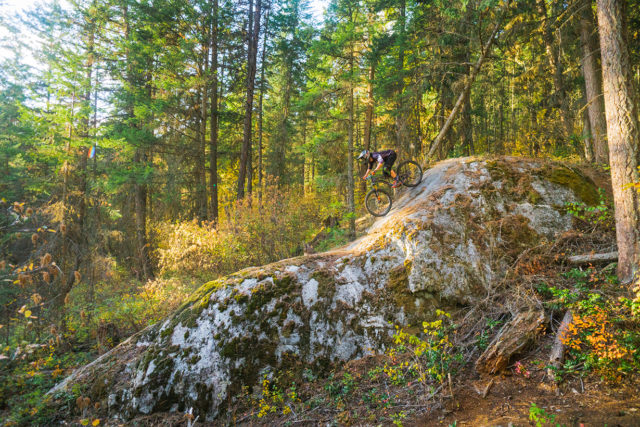
I think it’s also worth noting that, with roughly a 17% increase in the rate through the travel, the Elkat is probably progressive enough to run a coil shock without running into big issues with bottoming out. At the same time, it’s not so progressive that lighter riders with air shocks are going to struggle to use all of the bike’s travel. So in other words, it’ll likely be a good middle ground for a lot of riders.
For those who are interested, here’s the curve from Esker:
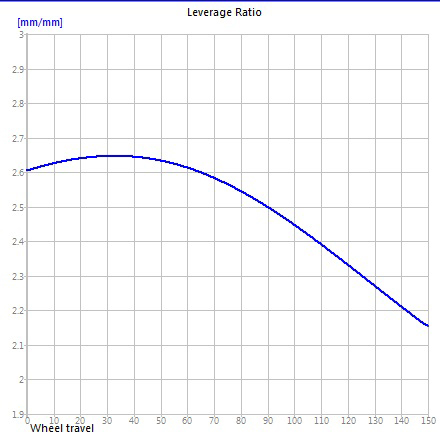
In terms of braking and pedaling characteristics, the Elkat felt like it erred on the side of preserving geometry under braking and stiffening up the suspension while pedaling. For braking, that means that the bike felt like it was less inclined to pitch forward under hard braking, but that also means that the rear end is maybe a bit less supple in those same situations.
For pedaling, the inclination for the suspension to stiffen up while laying power into the pedals means the bike feels less wallowy and soft while sprinting, but it also means the suspension is less active while pedaling hard. So that generally means that the bike probably performs better on smoother climbs and quick out-of-the-saddle sprints, but maintaining traction on loose and technical climbs might be trickier.
The main technical downside I see of the design is just that the concentric link around the bottom bracket is a bit more complex than your standard suspension pivot. I had zero issues with it during my time on the bike, but based on my time with other bikes with a similar pivot (namely, my Devinci Wilson), that pivot might require a bit more attention to keep it running smooth and creak free.
The Build
The build options on the Elkat are actually pretty great. It’s not that the parts available on the Elkat are anything unusual, but Esker offers a sort of ala-carte build option where you can upgrade whatever individual parts you want.
So to start, there’s a base build kit for the Esker. With that build, the bike costs $4,000, and comes with an 11-speed SLX drivetrain and Fox Performance level suspension. From there, you have a whole bunch of different upgrade options on pretty much every component on the bike.
Want better suspension but want to save some cash on the drivetrain? Stick with the SLX, but bump up to a Fox Factory 36 fork and DPX2 Factory rear shock for $300 more. Want some nice wheels? There are a few options, up to some Industry 9 carbon hoops for $1600.
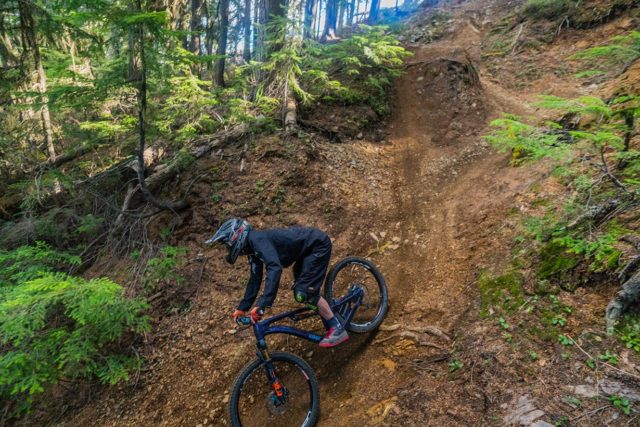
Overall, I think that’s an awesome way of offering complete bikes, and it makes it way easier to buy the bike you want, built the way you want. What would make it even better? More options, of course. In particular, more tire choices would be great; I’d love to see some options for Sram brakes (the internet tells me I’m in the minority, but I’ll take a Guide RSC over a Shimano XT any day of the week); and I’d like to see a Fox 36 with a Grip2 damper offered as well.
The other thing that would be great would be more options to “remove” any given part — to buy a complete bike except for 1 or 2 parts (e.g. you already have a nice wheelset, so you buy the bike without wheels). Currently, Esker only offers that option for the saddle.
The Elkat I rode was built with a pretty smart set of upgrades over the base model — a Fox 36 Factory fork, an XT 11-speed drivetrain and brakes, a Fox Transfer seatpost, Race Face SixC handlebars, and Terrene Chunk 2.6 tires.
The wheelset was a Stan’s Baron, which isn’t actually one of the options offered by Esker for production bikes, but it’s probably roughly comparable to the stock DT Swiss M1900 wheelset.
Everything on the build that I rode worked well for the time I had it. The XT drivetrain is a solid performer, although I occasionally missed the range of a 12-speed drivetrain. As I mentioned above, XT brakes work fine, but I prefer SRAM Guides — the XT’s don’t seem to hold a bleed as well, and they have a lot less modulation.
The Fox suspension does a great job, and the Fox 36 is definitely a worthwhile upgrade over the stock 34. I’d love to have the adjustability of the Grip2 damper, and I’d say the Fit4 damper errs more on the side of “supportive” than “supple,” but it’s still one of the best forks on the market.
At the rear of the bike, I mostly rode the Elkat with the stock Fox DPS performance, which works fine but isn’t notably good (or bad) in any given situation. I also got one ride on the Elkat with a Fox DPX2 Factory shock mounted up — small-bump sensitivity was maybe a bit better, but it didn’t make as much of a difference as I was expecting.
My test bike had the stock Ergon saddle, and I can’t say that I’m a huge fan. It’s shaped in a way that puts pressure on places that I don’t want pressure. Saddles are always a personal preference, but personally, I’d opt for the saddle delete option.
Some people likely noticed that there are a couple different tire options from Terrene on the build menu, and that might look a bit odd since Terrene is a relatively new and not-super-well-known brand. The reason here is that a bunch of the folks behind Esker are also behind Terrene.
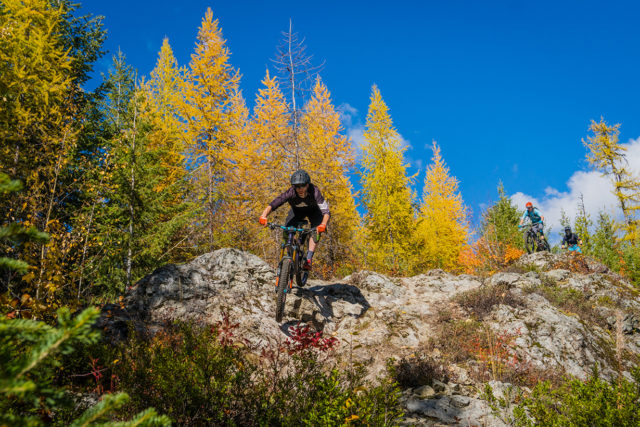
I’ve spent some time on the Terrene Chunk 2.6 in the past and gotten along with them pretty well, and my time on them on the Elkat didn’t change my opinion at all. I’d reiterate, though, that the Chunk 2.3 is an entirely different tire and I didn’t like it quite as much. The Chunk 2.3 is the only non-2.6 tire option available on the Esker, and I’d probably shy away from it. But again, just to circle around to my first point, the fact that you even have the option to pick which tires you want on your build is awesome, because with most companies you’re just stuck with whatever they give you.
I should also point out that between the tires, the drivetrain, and a few other bits and pieces on the bike, there was a bunch of room to save some weight on my test rig. So while it weighed in at a bit under 32 lbs (without pedals), I think getting the weight down to 30-ish lbs could be accomplished pretty easily. Primarily, I think it’s worth noting that most companies would spec a bike like this with 2.3-2.5” reinforced single-ply tires (e.g., a Maxxis Exo casing). Swapping to those sort of tires would immediately save a pound (or more) on the Elkat.
Fit and Geometry
Generally speaking, Esker went “modern and safe” with their geometry on the Elkat. It’s entirely in line with modern trends, but they didn’t go overboard on trying to make the bike ultra-progressive.
In terms of fit, that means it follows the longer / lower / slacker trend, but I didn’t feel super stretched out and I didn’t have to adjust my normal riding position to make the Elkat work right.

On the Medium Elkat I rode, the reach comes in at 440 mm, which I’d call spot-on average for a Medium these days. The seat tube angle is 75.9°, which, as of 3 years ago would be considered quite steep, but following industry trends, it’s actually pretty normal for a 2019 model-year bike. That steep seat tube angle keeps the top tube a bit shorter — at 587 mm on my Medium, the bike feels a bit less stretched out while seated than some other bikes that are still running slacker seat tubes (or longer reach numbers). I’ll get into how that affects the ride below.
In terms of handling, the Elkat’s geometry is, again, modern without going overboard. A 65.46° head angle is decently slack, but there are plenty of bikes that are slacker. 425 mm chainstays are on the short side of what most companies are doing these days. And all of those numbers produce a wheelbase (on a Medium) of 1183 mm, which is, again, pretty average for a modern bike.
If you’re a bit unclear on what all of those numbers mean, check out our Geometry 101 and 102 articles for a basic refresher on lengths and angles.
The Ride
Esker has been on something of a whirlwind demo tour this fall, so my time on the Elkat was snuck in between Outerbike and some other demo. The downside of this is that I only got about a week on the bike, which is less time than I’d usually get on a bike for a full review. The upside was that the week I had with the Elkat happened to coincide with a mid-fall trip I was taking to British Columbia to ride around Castlegar and Nelson. That means that I got to ride the Elkat on some of my favorite trails on the planet in prime conditions. South-central BC is the promised land when it comes to lots of steep loam and tech, and a decent helping of steep climbing, too.
Normally I like to ease into my time on a new bike and start out on my local trails that I know really well. But the Elkat showed up right before I left for Castlegar, so that wasn’t really an option. So day one on the Elkat involved a bunch of steep trails and fairly large, somewhat technical jumps. So whether I liked it or not, I needed to get comfortable on the Elkat as soon as possible.
And I’ve gotta say, about 200 feet into the first trail, hitting a big jump I’d never hit before, I thought to myself: “Huh. This bike feels… normal.”
Hitting drops and jumps, carving through corners, drifting through off-camber bits — all of it went impressively well, right from the get-go on the Elkat. And I don’t mean to say that the Elkat was doing anything mind-blowingly different in any of those situations, it’s just that I had a really easy time getting comfortable on the Elkat, really quickly.
That comfort level translated into a bunch of fun. In the week I spent on the bike, I hit quite a few lines and features around Nelson that I’d never hit before. Many of these were lines that I’d passed on before, on different bikes. Plenty of the features were things that I’d normally only try on a DH bike.
But I hit them (successfully) on the Elkat.
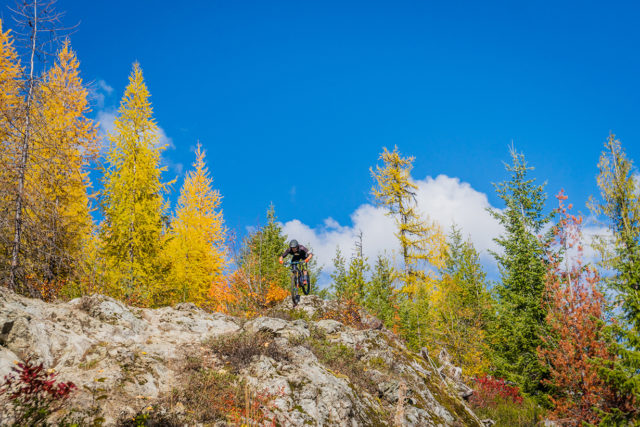
Now, some of that was definitely because conditions were prime. Rock slabs were dry, but not dusty. Runouts were tacky. Steep loam lines were in perfect shape.
And I definitely don’t want to give the impression that the Elkat is comparable to a DH bike. It’s not. And truth be told, there are other ~150mm-travel bikes that feel a bit plusher, or are a bit more progressive and handle big jumps and drops a little better. So it’s not that the Elkat’s suspension is markedly different than a lot of other 150mm-travel bikes.
It’s more that, as someone that tends to switch from bike to bike a fair amount, the Elkat just feels comfortable right from the start. It’s stable without feeling like a super-tanker. It’s efficient without giving up too much ground on the descents. And the fit is, for lack of a better word, normal. I didn’t have to adjust my riding style or position to feel comfortable on the bike.
Climbing on the Elkat feels pretty snappy. On smooth road climbs, there’s some noticeable bob in the rear shock, but on the whole, I’d say it’s pretty good compared to other bikes in this travel class. And for out-of-the-saddle bursts of power, the rear end noticeably firms up, which makes the bike feel a bit zippier when you put in the effort. Compared to some other bikes in this class, the Elkat maybe feels a bit less supple and ground-hugging on technical climbs, but it’s still not bad in that regard.
The Elkat’s short rear end keeps the rear wheel tucked up a little closer on climbs, which can make it easier to maintain traction in loose spots. Normally this would come at the cost of the bike wanting to wheelie on steep sections, but the steep seat tube angle takes care of that. Steeper climbs where the front end of most bikes start to get wandery were pretty easy on the Elkat — I was able to stay seated and pedal up steep climbs without feeling like I had to perch my ass on the forwardmost tip of the saddle.
But a bike like the Elkat is clearly built to have a good time on the descent, and solid climbing attributes really just help you stay a bit fresher for the fun part of the ride. And as I mentioned above, I had a pretty damn good time on the Elkat once things turned downhill.
The Elkat’s short rear end makes the bike feel pretty playful, and it’s easy to manual and pop every little bump. If I’m racing and I’m looking to go around corners as fast as possible, I tend to prefer a longer rear end — it makes it easier to adjust which wheel I’m weighting. But for good old-fashioned mountain-bike tomfoolery, the short chainstays on the Elkat are a good time. And when I’m not up against a clock, that short rear end makes it a bit easier to place the rear wheel exactly where I want it when I’m squaring off corners and looking for jumps.
In terms of the suspension, the Elkat strikes a middle ground (this shouldn’t really be surprising at this point). It’s progressive enough that I never felt like I was bottoming it out excessively — I definitely hit the bottom of the travel, but every time I did so, it was warranted. And mid-stroke support felt fine; I think the Fox shocks tend to do pretty well in that regard, and nothing about the suspension kinematics seemed to screw that up. The area where it seemed like there was a bit of room for improvement was on small-bump sensitivity — the Elkat wasn’t quite as responsive over little trail chatter as some of the other bikes in this class.
If I’d had a bit more time with the Elkat, I would have liked to add a volume spacer or two in the rear shock and reduce pressure a little bit. I was running 30% sag, and I would have liked to try increasing that by a couple percent. I did get a chance to swap on a Fox DPX2 rear shock for one ride, which allowed my to reduce the low-speed compression setting. That helped small-bump sensitivity a little bit, but not by as much as I’d hoped. My point here is really that I think there was probably room to improve the suspension action a bit, but I just didn’t have enough time to play with the shock to verify that.
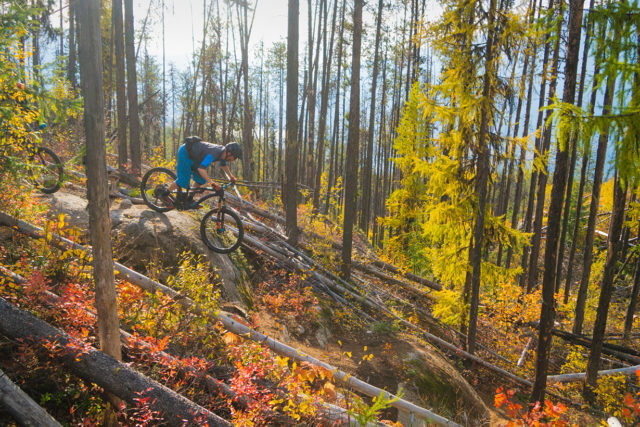
Particularly for a longer-travel bike like the Elkat, I find that some bikes fall a bit more on the playful, poppy, jump-off-of-everything end of the spectrum, while others want to just stay glued to the ground and plow through everything. And to be sure, a lot of that depends on suspension setup and fork choice. But generally speaking, I’d put the Elkat a bit more at the playful / poppy end of the spectrum. It prefers to pop over a rock garden than trundle through it. And it’s better suited to finding little things to play off of on the side of the trail than taking the straightest, fastest line down the middle.
While the suspension is a bit different and they don’t ride exactly the same, the bike that I kept thinking of while riding the Elkat was the second generation of the Santa Cruz Bronson (so that’d be a 2016 Bronson, not the new one with the lower shock-mounting position).
The Elkat’s geometry is a bit more modern than the Bronson’s, and the suspension traits aren’t identical. But they’re both bikes that, when I swung a leg over them, I didn’t really feel like I needed much time to get used to them. And it’s that user-friendliness that I think makes for a bike that’ll generally appeal to a pretty broad spectrum of riders.
To put all that another way, if you are particular about your bike and you know exactly what you’re looking for, there are better bikes than the Elkat. If you prioritize a bike that climbs ridiculously efficiently, there are bikes that pedal better than the Elkat (some of the Santa Cruz bikes, for instance). If you want something that’s super cushy, that hugs the ground, and crushes every little bump in its path, there are bikes that do that better, too (the Trek Remedy RSL comes to mind). And if you’re excited about a bike that really pushes the envelope of rider-forward geometry, there are bikes out there that are much more progressive than the Elkat in that respect (see: Mondraker, Pole, Nicolai, etc.).
But if you’re less focused on one particular attribute of the bike, or if you’re just not entirely sure what exactly you want and you’re looking for a safer middle ground, the Elkat is a pretty solid bet. Among ~150mm-travel bikes, the Elkat is a decent entry in the “jack of all trades, master of none” category. I’d say it errs on the side of being a better pedaler at the cost of plush crushiness, but that’s not to say it can’t hold its own on rough descents.
Bottom Line
For their first full-suspension bike, Esker has come out with a pretty compelling option. It seems like most of the bikes we see from newer, smaller companies are fairly niche products that cater to a very specific audience. The Elkat isn’t that — it’s decidedly middle-of-the-road in most respects, and that positions it as a good option for a lot of people. And that also means it’s up against the offerings of the biggest players in the business, so Esker has its work cut out.
But really, what I think sets the Elkat apart are the build options and the ability to significantly customize the bike without paying an exorbitant sum. There are plenty of times when I look at a bike and think “that’s a sweet build — I’d only want to swap out three of the parts.” Which is kind of a bummer when those three parts are going to cost $1000 and you already dropped a healthy chunk of change for the bike. Esker’s option to customize the build goes a long way toward alleviating that situation, and it’s not something that I’ve seen many other brands do.
Ultimately, the takeaway here is that the Elkat is a solid option that’s pretty at home on most trails that are appropriate for a long-ish-travel Trail bike. The Elkat is an easy bike to get along with, and Esker’s build options make it (relatively) affordable to kit out the bike as you see fit. So if that all sounds interesting, give the Elkat a serious look.



“Compared to some other bikes in this class, the Elkat maybe feels a bit less supple and ground-hugging on technical climbs, but it’s still not bad in that regard.”
What would you consider as other bikes in this class? And how would you compare it to a DW-link platform? I did notice Reach and geo numbers are similar to ibis ripmo (granted there is the 27.5 vs 29er debate there)
Sorry, super slow reply on this. But, generally speaking, I’d compare the Elkat to any 150-ish mm travel bike, especially those with 27.5″ wheels. So that’d be a Santa Cruz Bronson, Trek Remedy, Ibis Mojo HD4, probably a Specialized Stumpjumper, etc. Of those bikes, I’d put the Elkat a bit more on the pedal friendly side of the spectrum.
Comparing to DW bikes gets tricky because there’s a bunch of different bikes that use the DW platform, and a lot of those bikes are quite different. For example, a Pivot Firebird rides waaaaaay different than an Ibis Ripley. Obviously they have significantly different geometries and amounts of travel, but the suspension kinematics and shock tunes are also quite a bit different on each bike to achieve the intended purpose of each one. So I don’t think it’s really possible to compare the Elkat to DW link bikes in a general sense, but it’s certainly possible to compare it to specific DW link bikes.
There’s a bunch of comparable DW link bikes, but the Ibis Mojo HD4 is a good comparison in terms of geometry, travel, and overall intentions. Compared to the Elkat, I’d say the Mojo HD4 feels a bit more inclined to get rowdy on the descents, but the Elkat is a bit better climber. The Mojo is a little lighter, but the Elkat is cheaper. When I reviewed it, I said the Mojo was the most downhill-oriented bike that I’d still be willing to pedal uphill for a really long time. The Elkat backs off of that statement a notch – it’s slightly less downhill oriented, and slightly more uphill oriented, making it a little more well rounded, which may or may not be a good thing, depending on what you’re looking for.
Wow! Someone else who prefers Sram brakes over shimano! And even for the same reasons as me! Does that make me not as crazy, or does it make us both crazy?
Esker, please keep the Bronson fan boys in check. Thanks
Sram brake lovers: there are dozens of us!
Any chance you have ridden the Evil Calling? I am wondering how this bike compares to it…
Solid review, some good reviews coming out about this bike. Btw SRAM brakes feel slightly better but Shimano was waayy more reliable.
Noah!
At 5’9″ what’s your inseam, torso and arm length like as it looks like you are in between sizing and could ride a large Elkat as well… I was wondering what your thoughts are on testing/riding a large; going w/a 35mm stem?
While I could pretty happily ride either a medium or a large, if I was going to buy one, it’d be a large for sure. And yeah, like you said, I’d run a 35 or 40mm stem. To answer your more specific questions, I’m a 32ish inseam, and I have no idea what my torso and arm lengths are, but I’d call them pretty average for someone my height.
For the medium vs. large question (on pretty much any bike) the number I mostly look at is the effective top tube. The Elkat comes in at 610mm on the Large, which for me is comfortable – anything over 620ish starts to feel stretched out on climbs and it makes my back hurt (even with a short stem). But I prefer a longer bike on the way down, so somewhere at the upper end of that ETT range is usually where I like to land. Like I said – I was perfectly comfortable on the medium and had a bunch of fun on it, but given the option, I’d go large. For someone in the 5’9″ – 5’10” ballpark, I’d only suggest the medium if they had a clear preference towards a smaller bike (i.e. they want something that’s more manageable in slower speed, techier terrain). 5’8″ could kinda go either way. 5’7″ I’d steer towards a medium.
-Noah
Hi Noah sorry to bring back an old post but compare Elkat to the 2018 Marin Wolf Ridge, out of these two which would come up better in climbing, both smooth & technical if your memory still recalls? I’m looking at upgrading my trusted but aging Maverick ML8 (monolink rear suspension), but no 150-160mm bike has done better climbing wise so far.